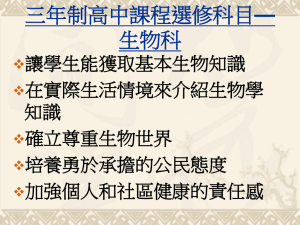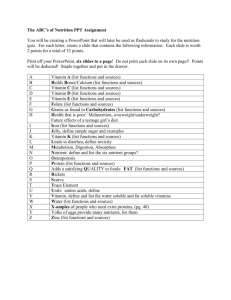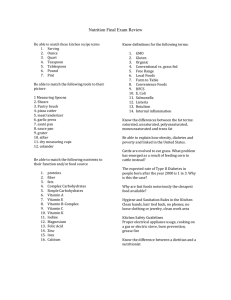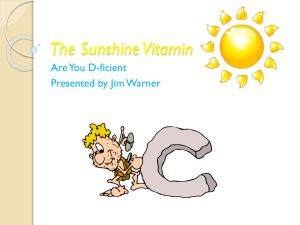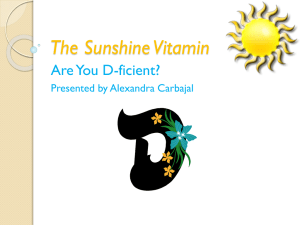Kuzma_Manuscript_15-0811R1_Vitamin D and memory decline
advertisement
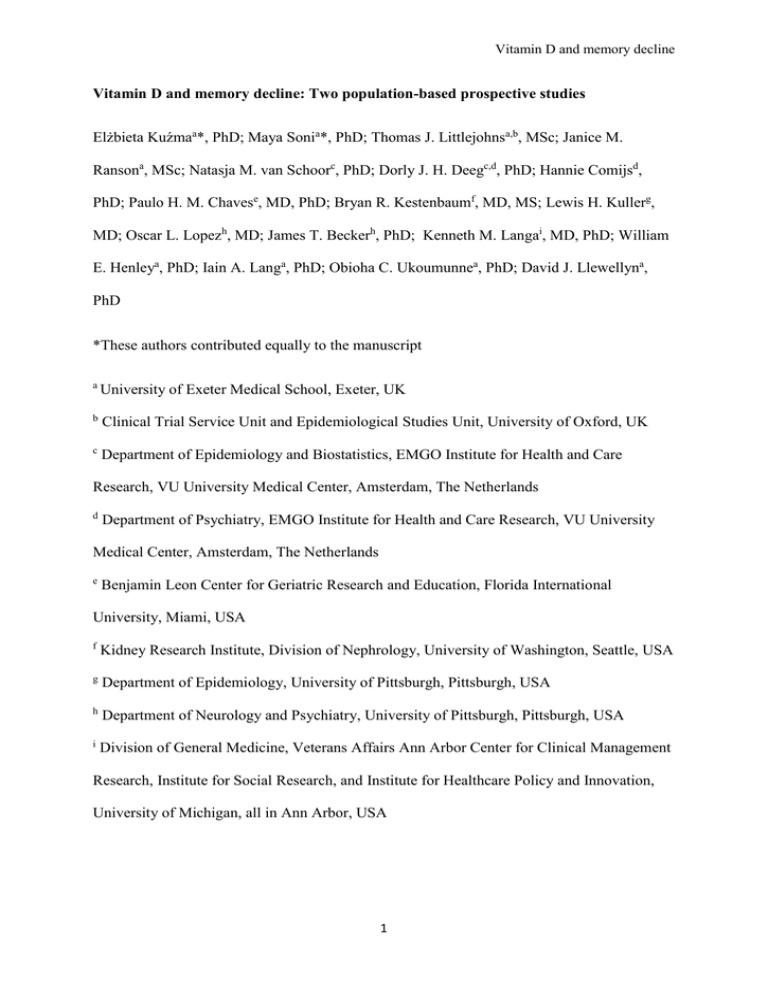
Vitamin D and memory decline Vitamin D and memory decline: Two population-based prospective studies Elżbieta Kuźmaa*, PhD; Maya Sonia*, PhD; Thomas J. Littlejohnsa,b, MSc; Janice M. Ransona, MSc; Natasja M. van Schoorc, PhD; Dorly J. H. Deegc,d, PhD; Hannie Comijsd, PhD; Paulo H. M. Chavese, MD, PhD; Bryan R. Kestenbaumf, MD, MS; Lewis H. Kullerg, MD; Oscar L. Lopezh, MD; James T. Beckerh, PhD; Kenneth M. Langai, MD, PhD; William E. Henleya, PhD; Iain A. Langa, PhD; Obioha C. Ukoumunnea, PhD; David J. Llewellyna, PhD *These authors contributed equally to the manuscript a University of Exeter Medical School, Exeter, UK b Clinical Trial Service Unit and Epidemiological Studies Unit, University of Oxford, UK c Department of Epidemiology and Biostatistics, EMGO Institute for Health and Care Research, VU University Medical Center, Amsterdam, The Netherlands d Department of Psychiatry, EMGO Institute for Health and Care Research, VU University Medical Center, Amsterdam, The Netherlands e Benjamin Leon Center for Geriatric Research and Education, Florida International University, Miami, USA f Kidney Research Institute, Division of Nephrology, University of Washington, Seattle, USA g Department of Epidemiology, University of Pittsburgh, Pittsburgh, USA h Department of Neurology and Psychiatry, University of Pittsburgh, Pittsburgh, USA i Division of General Medicine, Veterans Affairs Ann Arbor Center for Clinical Management Research, Institute for Social Research, and Institute for Healthcare Policy and Innovation, University of Michigan, all in Ann Arbor, USA 1 Vitamin D and memory decline Correspondening author: Dr David J. Llewellyn University of Exeter Medical School College House, Heavitree Road Exeter, UK, EX1 2LU Email: david.llewellyn@exeter.ac.uk 2 Vitamin D and memory decline Abstract Background: Vitamin D deficiency has been linked with dementia risk, cognitive decline and executive dysfunction. However, the association with memory remains largely unknown. Objective: To investigate whether low serum 25-hydroxyvitamin D (25(OH)D) concentrations are associated with memory decline. Methods: We used data on 1,291 participants from the US Cardiovascular Health Study (CHS) and 915 participants from the Dutch Longitudinal Aging Study Amsterdam (LASA) who were dementia-free at baseline, had valid vitamin D measurements and follow-up memory assessments. The Benton Visual Retention Test (in the CHS) and Rey’s Auditory Verbal Learning Test (in the LASA) were used to assess visual and verbal memory respectively. Results: In the CHS, those moderately and severely deficient in serum 25(OH)D changed 0.03 SD (95% CI: -0.06 to 0.01) and -0.10 SD (95% CI: -0.19 to -0.02) per year respectively in visual memory compared to those sufficient (p = 0.02). In the LASA, moderate and severe deficiency in serum 25(OH)D was associated with a mean change of 0.01 SD (95% CI: -0.01 to 0.02) and -0.01 SD (95% CI: -0.04 to 0.02) per year respectively in verbal memory compared to sufficiency (p = 0.34). Conclusions: Our findings suggest an association between severe vitamin D deficiency and visual memory decline but no association with verbal memory decline. They warrant further investigation in prospective studies assessing different memory subtypes. Keywords: Memory, cognition, vitamin D, prospective studies 3 Vitamin D and memory decline Introduction Recent meta-analyses confirm low serum vitamin D concentrations are linked with prevalent Alzheimer’s disease [1] and global cognitive decline [2]. A range of neuroprotective (e.g. increased phagocytosis of amyloid-beta peptide, regulation of neurotrophins and calcium homeostasis, anti-inflammatory and antioxidant action) mechanisms have been identified suggesting vitamin D may play a substantial role in preventing dementia [3-5]. However, the relationship with specific cognitive domains remains largely unknown. It has previously been hypothesized that vitamin D may be primarily associated with cognitive domains other than memory [6]. Our previous systematic review identified no prospective studies investigating the relationship between vitamin D and memory [7]. Cross-sectional studies suggested the association between vitamin D and memory may be less consistent than that observed for executive dysfunction [7]. Recent cross-sectional studies indicate a potential link with visual memory [8, 9] but not with verbal memory [9]. We therefore updated our systematic review to identify any new prospective studies and analyzed data from two large prospective population-based studies. Systematic review We updated our systematic review on vitamin D, memory and executive dysfunction (conducted May 2012) [7] focusing specifically on the prospective association with memory. Following a predefined protocol, we searched MEDLINE and PsycINFO from 2012 onwards without language restrictions using subject headings and free text terms, with forward and backward citation searching of included studies (Supplementary Figure 1). We included prospective observational or interventional studies with a mean follow-up of ≥1 year investigating the association between serum vitamin D concentrations and memory in adults aged 65 and over. We excluded publications without objectively assessed memory, 4 Vitamin D and memory decline conference abstracts, and manuscripts that did not include original research. Titles, abstracts and full-texts were screened independently by two reviewers (EK and JMR). Any discrepancies were resolved by discussion with a third reviewer (DJL). Our searches yielded a total of 397 references. After removing 90 duplicates, 295 records were excluded after title and abstract screening. We conducted a full-text review of 12 publications though none met our inclusion criteria (Supplementary Figure 2). Our systematic review established that no previous study had investigated the relationship between vitamin D and long-term memory decline in older adults. Therefore, we identified through prior publications and existing collaborations two prospective population-based studies including vitamin D measurements and memory assessments: the US Cardiovascular Health Study (CHS) [10] and the Dutch Longitudinal Aging Study Amsterdam (LASA) [11]. We did not conduct a meta-analysis due to heterogeneous outcomes included in each study (visual vs. verbal memory). Methods Data and study populations We used data from the CHS and LASA to investigate the relationship between vitamin D and memory. The CHS recruited 5,201 older adults in 1989-1990 and an additional 687 AfricanAmerican participants in 1992-1993 from four communities in the US and assessed them annually through 1999 [10]. Serum 25-hydroxyvitamin D (25(OH)D) concentrations were measured in blood samples collected at the 1992-1993 study visit (baseline for the current study) in 2,312 participants free from cardiovascular disease and with sufficient serum volumes (≥500 ul) [12]. The LASA was initiated in 1992 and included 3,107 adults from three geographic regions in the Netherlands [11]. Participants were assessed every three to four years thereafter. Blood samples for measurement of 25(OH)D were collected in 19955 Vitamin D and memory decline 1996 (baseline for the current study) from 1,352 participants aged 65 and older and valid vitamin D measurements were obtained from 1,320 samples [13]. The end of follow-up for the current study was the 2008-2009 study visit. We restricted both samples to dementia-free participants [14, 15] aged 65 and older at baseline with valid vitamin D assessment and ≥2 cognitive assessments. In the CHS, dementia status was adjudicated according to the National Institute of Neurological and Communicative Diseases and Stroke/Alzheimer’s Disease and Related Disorders Association (NINCDS-ADRDA) criteria [14] whereas in the LASA probable dementia (persistent cognitive decline of more than two standard deviations (SD) below the mean decline with continued decline during follow-up) was identified based on available data as previously described [15]. We also excluded those with baseline memory scores that precluded substantial decline defined as ≥1 SD decrease greater than the mean change score from baseline to final assessment [16] (scores <3 and <8 in the CHS and LASA respectively). Baseline global cognitive scores did not preclude substantial decline defined as a decline of ≥5 points on the 3MSE [17] and ≥3 points on the MMSE from baseline to final assessment [18] for any participants. This resulted in 1,291 CHS and 915 LASA participants in analyses of memory decline (primary outcome), and 1,612 and 1,074 respectively for global cognitive decline (secondary outcome). Ethical approval and informed consent Institutional review boards at CHS participating institutions approved research protocols. The LASA study protocol was approved by the Medical Ethics Committee of the VU University Medical Center. All participants provided written informed consent. Serum 25(OH)D measurement In the CHS, serum samples were collected in 1992-1993 and stored at -70 ºC [12]. In 2008, 25(OH)D was measured using high-performance liquid chromatography-tandem mass 6 Vitamin D and memory decline spectrometry on a Waters Quattro micro mass spectrometer (Waters Corporation, Milford, Massachusetts) with the inter-assay coefficient of variation of <3.4% [12]. The assay was validated using the Standard Reference Material 972 developed by the National Institute of Standards and Technology [19]. In the LASA, serum samples were obtained in 1995-1996 and stored at -20 ºC until 25(OH)D measurement in 1997-1998. A competitive protein binding assay (Nichols Diagnostics, San Juan Capistrano, CA) was used to determine 25(OH)D concentrations with an inter-assay coefficient of variation of 10% [20]. In both cohorts, serum 25(OH)D concentrations were divided into clinically relevant categories: sufficient (≥50 nmol/L), moderately deficient (≥25 to <50 nmol/L) and severely deficient (<25 nmol/L) [21]. We also analyzed serum 25(OH)D concentrations as a standardized continuous variable with a mean of zero and a SD of one. Cognitive assessment In the CHS, visual memory was assessed by the Benton Visual Retention Test (BVRT) [22] consisting of ten designs one, two, three, four and six years after the study baseline [17]. Scores range from 0 to 10 with higher scores representing better visual memory. Global cognition was assessed annually using the Modified Mini-Mental State Examination (3MSE; range 0 to 100) [23] with higher scores representing better global cognition [17]. In the LASA, cognition was assessed at baseline and after three, six, ten and thirteen years [16]. Verbal memory was assessed using immediate (three trials) and delayed (one trial) recall of 15 words on an abbreviated Dutch version of the Rey’s Auditory Verbal Learning Test [24]. In addition to immediate word recall (score on the third trial, range 0 to 15) and delayed word recall (range 0 to 15), we derived a total verbal memory score as the sum of 7 Vitamin D and memory decline immediate and delayed recall (range 0 to 30) with higher scores representing better verbal memory. Global cognition was assessed with the Mini-Mental State Examination (MMSE; range 0 to 30) with higher scores representing better global cognition [25]. The 3MSE and the MMSE are highly correlated measures of global cognition [26]. Substantial memory decline was defined as ≥1 SD decrease greater than the mean change score in both cohorts from baseline to final assessment [16]. Substantial global cognitive decline was defined as a decline of ≥5 points on the 3MSE [17] and ≥3 points on the MMSE from baseline to final assessment [18]. Covariates Analyses were adjusted for covariates previously identified as potential confounders [1, 5, 7, 27] and to address the possibility of reverse causation [5]: age in years, season of blood collection (March-May, June-August, September-November, December-February), education (CHS: did not finish high school, finished high school/some college/vocational qualifications, completed college/professional qualifications; LASA: in years), sex, income (low, middle, high and missing; in the CHS: <$25,000, $25,000-$49,999, and ≥$50,000 per annum [28]; in the LASA: < €1,134, €1,135-€1,816, >€1,816 per month [29]), body mass index (BMI in kg/m2), smoking (non-smoker, current smoker), alcohol consumption (US National Institute on Alcohol Abuse and Alcoholism guidelines for older adults: non-drinkers, moderate drinkers [≤7 drinks per week], heavy drinkers [>7 drinks per week]), depressive symptoms (CHS: ≥8 on the revised 10-item Center for Epidemiologic Studies Depression Scale (CESD) [30]; LASA: ≥16 on the 20-item Dutch version of the CES-D [31]) and gait impairment (gait speed <0.5 m/s and/or use of assistive devices [32]). Statistical analyses 8 Vitamin D and memory decline We summarized baseline characteristics of the CHS and LASA samples across vitamin D categories using percentages for categorical variables, means and standard deviations for normally distributed continuous variables, and medians and interquartile ranges for skewed continuous variables. Linear mixed-effects regression models were fitted to estimate the mean difference in annual change in memory and global cognition (outcomes) between vitamin D deficient categories and the sufficient (reference) category. Data were reshaped into long format so that all responses (at baseline and follow-up) for a given outcome were analyzed as a single variable with a time variable indicating when the outcome was measured. Basic adjusted models included the covariates: time, vitamin D category, interaction term between vitamin D category and time, baseline age and season of blood collection. Coefficients for the interaction variable indicate mean differences in annual change between vitamin D deficient categories and the sufficient category. Fully adjusted models additionally included baseline education, sex, income, BMI, smoking, alcohol consumption, depressive symptoms and gait impairment. Linear mixed-effects regression models with random intercept and random slope for the time variable, specifying the study participant as the grouping or clustering variable, were fitted as they allow for correlation between responses over time from the same participant. Mean differences in memory and global cognition were converted to SD units by dividing the raw score differences by the baseline SD of each test in the analytic sample in each study in order to aid interpretability and comparability. We used Poisson regression models with a robust error variance [33] to estimate relative risk (RR) of substantial memory and global cognitive decline associated with baseline vitamin D categories. In basic adjusted models, we controlled for age, season of vitamin D collection, baseline memory or global cognitive score and years of follow-up. In fully adjusted models, 9 Vitamin D and memory decline we also included baseline education, sex, income, BMI, smoking, alcohol consumption, depressive symptoms and gait impairment. In sensitivity analyses, we first repeated the above analyses using attrition weighting to assess the potential influence of differential loss to follow-up. Weights were defined as the inverse probability of having completed at least one follow-up cognitive assessment and calculated by fitting logistic regression models to follow-up status (outcome) using key predictors (25[OH]D category, age, sex, education, income, season of vitamin D collection, baseline cognition, BMI, smoking, alcohol consumption, depressive symptoms and gait impairment). Since there was little difference between findings from the non-weighted and weighted analyses the former are reported here. We then analyzed serum 25(OH)D concentrations as a continuous rather than a categorical variable. Furthermore, we repeated the main analyses adjusting for ethnicity (white/black) in the CHS and excluding non-white participants in the LASA as they represented only 1% of the sample. In the LASA we also repeated the main analyses to investigate the association between vitamin D categories and immediate and delayed word recall separately. Results Results from the CHS Baseline characteristics of CHS participants included in analyses of memory are presented in Table 1. We present here only fully adjusted results as there was little difference between basic and fully adjusted models (Tables 3 and 4). For visual memory, those moderately and severely deficient in serum 25(OH)D changed 0.03 SD (95% CI: -0.06 to 0.01) and -0.10 SD (95% CI: -0.19 to -0.02) per year respectively compared to those sufficient (p = 0.02; Table 3). The RR for substantial decline in visual 10 Vitamin D and memory decline memory in those moderately and severely 25(OH)D deficient was 1.08 (95% CI: 0.87 to 1.34) and 1.32 (95% CI: 0.87 to 2.01) respectively compared to those sufficient (p = 0.37; Table 3). For global cognition, those moderately and severely deficient in serum 25(OH)D changed 0.01 SD (95% CI: -0.04 to 0.03) and -0.05 SD (95% CI: -0.13 to 0.02) per year respectively compared to those sufficient (p = 0.37; Table 4). The RR for substantial decline in global cognition in those moderately and severely 25(OH)D deficient was 1.22 (95% CI: 0.97 to 1.53) and 1.73 (95% CI: 1.22 to 2.45) respectively compared to those sufficient (p = 0.007; Table 4). Sensitivity analyses with continuous serum 25(OH)D concentrations yielded similar results. Every SD increase in 25(OH)D concentrations was associated with a slower rate of decline in visual memory of 0.02 SD (95% CI: 0.004 to 0.03, p = 0.01) per year. The association between 25(OH)D concentrations and substantial memory decline was not significant (RR = 0.97, 95% CI: 0.87 to 1.07, p = 0.53). For global cognition, every SD increase in 25(OH)D concentrations was associated with a mean change of 0.01 SD (95% CI: -0.01 to 0.02, p = 0.37) per year. The association between 25(OH)D concentrations and substantial global cognitive decline was not significant (RR = 0.96, 95% CI: 0.85 to 1.07, p = 0.44). Additional adjustment for ethnicity did not change the pattern of results for either outcome (Supplementary Tables 1 and 2). Results from the LASA Baseline characteristics of LASA participants included in analyses of memory are presented in Table 2. In the LASA, there was also little difference between basic and fully adjusted models (Tables 3 and 4) therefore we present fully adjusted results. 11 Vitamin D and memory decline For verbal memory, moderate and severe deficiency in serum 25(OH)D was associated with a mean change of 0.01 SD (95% CI: -0.01 to 0.02) and -0.01 SD (95% CI: -0.04 to 0.02) per year respectively compared to sufficiency (p = 0.34; Table 3). The RR for substantial decline in verbal memory in those moderately and severely 25(OH)D deficient was 0.83 (95% CI: 0.63 to 1.11) and 1.04 (95% CI: 0.62 to 1.76) respectively compared to those sufficient (p = 0.42; Table 3). For global cognition, those moderately and severely deficient in serum 25(OH)D changed 0.03 SD (95% CI: -0.05 to -0.004) and -0.08 SD (95% CI: -0.12 to -0.04) per year respectively compared to those sufficient (p <0.001; Table 4). The RR for substantial decline in global cognition in those moderately and severely 25(OH)D deficient was 0.94 (95% CI: 0.77 to 1.14) and 1.12 (95% CI: 0.84 to 1.48) respectively compared to those sufficient (p = 0.43; Table 4). Sensitivity analyses revealed continuous 25(OH)D concentrations in SD units were not associated with annual change in verbal memory (0.0002 SD, 95% CI: -0.01 to 0.01, p = 0.97) or substantial verbal memory decline (RR = 1.04, 95% CI: 0.90 to 1.20, p = 0.58). For global cognition, every SD increase in 25(OH)D concentrations was associated with a slower rate of decline in global cognition of 0.02 SD (95% CI: 0.01 to 0.03, p = 0.001) per year. 25(OH)D concentrations were not associated with the risk of substantial global cognitive decline (RR = 1.00, 95% CI: 0.91 to 1.09, p = 0.93). Excluding non-white participants did not change the pattern of results for either outcome (Supplementary Tables 1 and 2). The same pattern of results was also observed for both immediate and delayed word recall (Supplementary Table 1). Discussion 12 Vitamin D and memory decline Our systematic review confirms no previous long-term population-based studies of older adults have investigated the association between vitamin D and memory decline. In the CHS, severe vitamin D deficiency was significantly associated with greater decline in visual memory compared to sufficiency. In the LASA, there was no significant association with verbal memory. For global cognition, severe vitamin D deficiency was significantly linked with increased risk of substantial decline in the CHS whereas in the LASA, moderate and severe vitamin D deficiencies were significantly associated with greater decline compared to sufficiency. Our results add to the ongoing debate on the association between vitamin D and specific cognitive domains. A recent prospective study of 318 older adults observed that those moderately and severely deficient in serum 25(OH)D (30 to <50 and <30 nmol/L respectively) experienced significantly greater annual decline in verbal memory (immediate and delayed word list recall) compared to those sufficient (50 to <125 nmol/L) over a mean of 4.8 years.[34] In the LASA, a similar measure of verbal memory was used, but we did not find a significant association. This may result from substantial methodological differences: Miller and colleagues [34] incorporated participants from a community outreach study and memory clinic referrals, had a shorter follow-up period, and used a competitive immunoassay with different cut points to measure serum 25(OH)D. They did not include a measure of visual memory, so it was not possible to compare with our CHS results. Taken together, these results suggest that there may be an association between low vitamin D levels and memory decline which is weaker than that observed for other cognitive domains [6]. We therefore hypothesize that the previously observed relationship between low vitamin D and an increased risk of Alzheimer’s disease (AD) [27, 35] is driven by non-amnestic cognitive decline, and in particular executive dysfunction. Further prospective studies incorporating multiple measures of memory are needed to confirm whether there is a differential pattern of 13 Vitamin D and memory decline association between visual and verbal memory. Our findings for global cognition are consistent with previous prospective studies showing increased global cognitive decline [2] and risk of all-cause dementia [27, 35, 36]. Several neurodegenerative and vascular mechanisms have been identified explaining the association between vitamin D, cognition and dementia [3-5]. Executive dysfunction is more strongly linked with cerebrovascular disease than neurodegeneration [37]. Low 25(OH)D levels are associated with an increased risk of stroke, particularly ischemic [38]. Given that stroke is an important dementia risk factor [39], vascular mechanisms may drive the association with dementia. Cross-sectional neuroimaging studies indicate the link with cerebrovascular abnormalities may be stronger than with neurodegeneration, including hippocampal atrophy [4]. However, the only prospective neuroimaging study found no association between vitamin D and white matter hyperintensities or infarcts [40]. Future prospective neuroimaging studies are warranted to establish whether vascular abnormalities mediate the association between low vitamin D and dementia to a greater degree than neurodegenerative markers. Our study has several strengths. We incorporate a systematic review and analyses of two large prospective population-based studies including both men and women in the US and Europe. The long follow-up and the exclusion of participants with prevalent dementia in both studies make reverse causation less likely. Sensitivity analyses using attrition weighting suggest that it is unlikely that non-random attrition accounts for the associations observed. Our study also has several limitations. While the CHS included white and African-American elders it did not incorporate other ethnicities, and the LASA sample was predominantly white. The competitive protein-binding assay used in the LASA is less accurate than the liquid chromatography-tandem mass spectrometry used in the CHS which may have contributed to the heterogeneity of results [41]. A previous meta-analysis of vitamin D and 14 Vitamin D and memory decline prevalent AD observed significant heterogeneity depending on the assay used [1]. Different aspects of memory were assessed in each cohort using a single test making comparisons more challenging and further large population-based or well-designed interventional studies are needed to exclude the possibility of chance findings. Results may have been attenuated in the LASA due to regression dilution bias linked to the longer follow-up period [42], and in the CHS due to the exclusion of participants with cardiovascular disease at baseline. Conclusions Our systematic review establishes no previous long-term population-based studies of older adults have investigated the association between vitamin D and memory decline. Our findings suggest an association between low vitamin D levels and decline in visual memory in the CHS, but no association with verbal memory in the LASA. Clarification of the mechanisms mediating the associations with vitamin D deficiency will inform the design of future vitamin D supplementation trials to prevent or delay cognitive decline and dementia. Acknowledgements The Cardiovascular Health Study was supported by contracts HHSN268201200036C, HHSN268200800007C, N01 HC55222, N01HC85079, N01HC85080, N01HC85081, N01HC85082, N01HC85083, N01HC85086, and grant HL080295 from the National Heart, Lung, and Blood Institute (NHLBI), with additional contribution from the National Institute of Neurological Disorders and Stroke (NINDS). Additional support was provided by AG023629, AG20098, AG15928 and HL084443 from the National Institute on Aging (NIA). A full list of principal CHS investigators and institutions can be found at www.chs-nhlbi.org. The Longitudinal Aging Study Amsterdam is largely supported by a grant from the Netherlands Ministry of Health Welfare and Sports, Directorate of Long-Term Care. Additional support was also provided by NIRG-11-200737 from the Alzheimer’s 15 Vitamin D and memory decline Association, the Mary Kinross Charitable Trust, the Halpin Trust, the Age Related Diseases and Health Trust, the Norman Family Charitable Trust (to D.J.L.), the Rosetreees Trust (to D.J.L. and M.S.), and the James Tudor Foundation (to D.J.L. and E.K.). This report presents independent research supported by the UK National Institute for Health Research (NIHR) Collaboration for Leadership in Applied Health Research and Care (CLAHRC) for the South West Peninsula. None of the funding sources had any role in the design of the study; in the analysis and interpretation of the data; or in the preparation of the manuscript. The views expressed in this publication are those of the authors and not necessarily those of the NHS, the NIHR, and the Department of Health in England or the National Institutes of Health (NIH). The NIH was involved in the original design and conduct of the Cardiovascular Health Study and in the data collection methods. The authors have no conflicts of interest to declare. An early version of this study was presented in part at the Alzheimer’s Association International Conference (AAIC), July 18-23, 2015, in Washington, D.C. 16 Vitamin D and memory decline References [1] Balion C, Griffith LE, Strifler L, Henderson M, Patterson C, Heckman G, Llewellyn DJ, Raina P (2012) Vitamin D, cognition, and dementia: a systematic review and meta-analysis. Neurology 79, 1397-1405. [2] Etgen T, Sander D, Bickel H, Sander K, Forstl H (2012) Vitamin D deficiency, cognitive impairment and dementia: a systematic review and meta-analysis. Dement Geriatr Cogn Disord 33, 297-305. [3] Annweiler C, Dursun E, Feron F, Gezen-Ak D, Kalueff AV, Littlejohns T, Llewellyn DJ, Millet P, Scott T, Tucker KL, Yilmazer S, Beauchet O (2015) 'Vitamin D and cognition in older adults': updated international recommendations. J Intern Med 277, 45-57. [4] Littlejohns TJ, Kos K, Henley WE, Kuźma E, Llewellyn DJ (in press) Vitamin D and dementia. J Prev Alz Dis. [5] Dickens AP, Lang IA, Langa KM, Kos K, Llewellyn DJ (2011) Vitamin D, cognitive dysfunction and dementia in older adults. CNS Drugs 25, 629-639. [6] Llewellyn DJ, Langa KM, Lang IA (2009) Serum 25-hydroxyvitamin D concentration and cognitive impairment. J Geriatr Psychiatry Neurol 22, 188-195. [7] Annweiler C, Montero-Odasso M, Llewellyn DJ, Richard-Devantoy S, Duque G, Beauchet O (2013) Meta-analysis of memory and executive dysfunctions in relation to vitamin D. J Alzheimers Dis 37, 147-171. [8] Darwish H, Zeinoun P, Ghusn H, Khoury B, Tamim H, Khoury SJ (2015) Serum 25hydroxyvitamin D predicts cognitive performance in adults. Neuropsychiatr Dis Treat 11, 2217-2223. [9] Nagel G, Herbolsheimer F, Riepe M, Nikolaus T, Denkinger MD, Peter R, Weinmayr G, Rothenbacher D, Koenig W, Ludolph AC, von Arnim CA (2015) Serum vitamin D 17 Vitamin D and memory decline concentrations and cognitive function in a population-based study among older adults in south Germany. J Alzheimers Dis 45, 1119-1126. [10] Fried LP, Borhani NO, Enright P, Furberg CD, Gardin JM, Kronmal RA, Kuller LH, Manolio TA, Mittelmark MB, Newman A, et al. (1991) The Cardiovascular Health Study: design and rationale. Ann Epidemiol 1, 263-276. [11] Huisman M, Poppelaars J, van der Horst M, Beekman AT, Brug J, van Tilburg TG, Deeg DJ (2011) Cohort profile: the Longitudinal Aging Study Amsterdam. Int J Epidemiol 40, 868-876. [12] Kestenbaum B, Katz R, de Boer I, Hoofnagle A, Sarnak MJ, Shlipak MG, Jenny NS, Siscovick DS (2011) Vitamin D, parathyroid hormone, and cardiovascular events among older adults. J Am Coll Cardiol 58, 1433-1441. [13] van Schoor NM, Knol DL, Deeg DJ, Peters FP, Heijboer AC, Lips P (2014) Longitudinal changes and seasonal variations in serum 25-hydroxyvitamin D levels in different age groups: results of the Longitudinal Aging Study Amsterdam. Osteoporos Int 25, 1483-1491. [14] Lopez OL, Kuller LH, Fitzpatrick A, Ives D, Becker JT, Beauchamp N (2003) Evaluation of dementia in the cardiovascular health cognition study. Neuroepidemiology 22, 1-12. [15] van den Kommer TN, Comijs HC, Dik MG, Jonker C, Deeg DJ (2008) Development of classification models for early identification of persons at risk for persistent cognitive decline. J Neurol 255, 1486-1494. [16] Dik MG, Jonker C, Bouter LM, Geerlings MI, van Kamp GJ, Deeg DJH (2000) APOE-ε4 is associated with memory decline in cognitively impaired elderly. Neurology 54, 1492-1497. 18 Vitamin D and memory decline [17] Kuller LH, Shemanski L, Manolio T, Haan M, Fried L, Bryan N, Burke GL, Tracy R, Bhadelia R (1998) Relationship Between ApoE, MRI Findings, and Cognitive Function in the Cardiovascular Health Study. Stroke 29, 388-398. [18] Geerlings MI, Schoevers RA, Beekman AT, Jonker C, Deeg DJ, Schmand B, Ader HJ, Bouter LM, Van Tilburg W (2000) Depression and risk of cognitive decline and Alzheimer's disease. Results of two prospective community-based studies in The Netherlands. Br J Psychiatry 176, 568-575. [19] Phinney KW (2008) Development of a standard reference material for vitamin D in serum. Am J Clin Nutr 88, 511S-512S. [20] Kuchuk NO, Pluijm SM, van Schoor NM, Looman CW, Smit JH, Lips P (2009) Relationships of serum 25-hydroxyvitamin D to bone mineral density and serum parathyroid hormone and markers of bone turnover in older persons. J Clin Endocrinol Metab 94, 1244-1250. [21] Ross AC, Manson JE, Abrams SA, Aloia JF, Brannon PM, Clinton SK, DurazoArvizu RA, Gallagher JC, Gallo RL, Jones G, Kovacs CS, Mayne ST, Rosen CJ, Shapses SA (2011) The 2011 Report on Dietary Reference Intakes for Calcium and Vitamin D from the Institute of Medicine: What Clinicians Need to Know. J Clin Endocrinol Metab 96, 53-58. [22] Benton AL (1972) Abbreviated versions of the Visual Retention Test. J Psychol 80, 189-192. [23] Teng EL, Chui HC (1987) The Modified Mini-Mental State (3MS) examination. J Clin Psychiatry 48, 314-318. [24] Rey A (1941) L'examen psychologique dans les cas d'encéphalopathie traumatique. (Les problems.). [The psychological examination in cases of traumatic encepholopathy. Problems.]. Arch Psychol 28, 215-285. 19 Vitamin D and memory decline [25] Folstein MF, Folstein SE, McHugh PR (1975) Mini-mental state: A practical method for grading the cognitive state of patients for the clinician. J Psychiat Res 12, 189198. [26] Bassuk SS, Murphy JM (2003) Characteristics of the Modified Mini-Mental State Exam among elderly persons. J Clin Epidemiol 56, 622-628. [27] Littlejohns TJ, Henley WE, Lang IA, Annweiler C, Beauchet O, Chaves PH, Fried L, Kestenbaum BR, Kuller LH, Langa KM, Lopez OL, Kos K, Soni M, Llewellyn DJ (2014) Vitamin D and the risk of dementia and Alzheimer disease. Neurology 83, 920-928. [28] Mozaffarian D, Kamineni A, Carnethon M, Djoussé L, Mukamal KJ, Siscovick D (2009) Lifestyle risk factors and new-onset diabetes mellitus in older adults: The Cardiovascular Health Study. Arch Intern Med 169, 798-807. [29] Dijkstra SC, Neter JE, Brouwer IA, Huisman M, Visser M (2014) Adherence to dietary guidelines for fruit, vegetables and fish among older Dutch adults; the role of education, income and job prestige. J Nutr Health Aging 18, 115-121. [30] Radloff LS (1977) The CES-D Scale: A Self-Report Depression Scale for Research in the General Population. Appl Psychol Meas 1, 385-401. [31] Beekman AT, Deeg DJ, Van Limbeek J, Braam AW, De Vries MZ, Van Tilburg W (1997) Criterion validity of the Center for Epidemiologic Studies Depression scale (CES-D): results from a community-based sample of older subjects in The Netherlands. Psychol Med 27, 231-235. [32] Lang IA, Llewellyn DJ, Langa KM, Wallace RB, Huppert FA, Melzer D (2008) Neighborhood deprivation, individual socioeconomic status, and cognitive function in older people: analyses from the English Longitudinal Study of Ageing. J Am Geriatr Soc 56, 191-198. 20 Vitamin D and memory decline [33] Zou G (2004) A Modified Poisson Regression Approach to Prospective Studies with Binary Data. Am J Epidemiol 159, 702-706. [34] Miller JW, Harvey DJ, Beckett LA, Green R, Farias ST, Reed BR, Olichney JM, Mungas DM, DeCarli C (2015) Vitamin D Status and Rates of Cognitive Decline in a Multiethnic Cohort of Older Adults. JAMA Neurol. [Epub ahead of print]. [35] Afzal S, Bojesen SE, Nordestgaard BG (2014) Reduced 25-hydroxyvitamin D and risk of Alzheimer's disease and vascular dementia. Alzheimers Dement 10, 296-302. [36] Knekt P, Saaksjarvi K, Jarvinen R, Marniemi J, Mannisto S, Kanerva N, Heliovaara M (2014) Serum 25-hydroxyvitamin d concentration and risk of dementia. Epidemiology 25, 799-804. [37] Kling MA, Trojanowski JQ, Wolk DA, Lee VMY, Arnold SE (2013) Vascular disease and dementias: Paradigm shifts to drive research in new directions. Alzheimers Dement 9, 76-92. [38] Brondum-Jacobsen P, Nordestgaard BG, Schnohr P, Benn M (2013) 25hydroxyvitamin D and symptomatic ischemic stroke: an original study and metaanalysis. Ann Neurol 73, 38-47. [39] Savva GM, Stephan BC (2010) Epidemiological studies of the effect of stroke on incident dementia: a systematic review. Stroke 41, e41-46. [40] Michos ED, Carson KA, Schneider AL, Lutsey PL, Xing L, Sharrett AR, Alonso A, Coker LH, Gross M, Post W, Mosley TH, Gottesman RF (2014) Vitamin D and subclinical cerebrovascular disease: the Atherosclerosis Risk in Communities brain magnetic resonance imaging study. JAMA Neurol 71, 863-871. [41] Lensmeyer GL, Wiebe DA, Binkley N, Drezner MK (2006) HPLC method for 25hydroxyvitamin D measurement: comparison with contemporary assays. Clin Chem 52, 1120-1126. 21 Vitamin D and memory decline [42] Clarke R, Shipley M, Lewington S, Youngman L, Collins R, Marmot M, Peto R (1999) Underestimation of risk associations due to regression dilution in long-term follow-up of prospective studies. Am J Epidemiol 150, 341-353. 22 Vitamin D and memory decline Table 1. Baseline characteristics of CHS participants included in analyses of memory by serum 25(OH)D category Characteristic Serum 25(OH)D, nmol/L All ≥50 ≥25 to <50 <25 N = 1,291 N = 937 N = 309 N = 45 Age (y), median (IQR) 72 (70-75) 72 (70-75) 72 (70-75) 72 (70-76) Female, n (%) 875 (67.8) 601 (64.1) 236 (76.4) 38 (84.4) Dec-Feb 266 (20.6) 157 (16.8) 93 (30.1) 16 (35.6) Mar-May 298 (23.1) 166 (17.7) 114 (36.9) 18 (40.0) Jun-Aug 370 (28.7) 319 (34.0) 45 (14.6) 6 (13.3) Sep-Nov 357 (27.7) 295 (31.5) 57 (18.5) 5 (11.1) Did not finish high school 216 (16.8) 151 (16.1) 56 (18.2) 9 (20.0) Finished high school/some 740 (57.4) 537 (57.4) 176 (57.1) 27 (60.0) 333 (25.8) 248 (26.5) 76 (24.7) 9 (20.0) 26.6 (4.5) 26.1 (4.1) 27.9 (5.1) 27.9 (5.7) Low 618 (47.9) 435 (46.4) 155 (50.2) 28 (62.2) Middle 395 (30.6) 303 (32.3) 83 (26.9) 9 (20.0) High 207 (16.0) 160 (17.1) 42 (13.6) 5 (11.1) Missing 71 (5.5) 39 (4.2) 29 (9.4) 3 (6.7) 112 (8.9) 74 (8.1) 34 (11.2) 4 (9.1) Season tested, n (%) Education (N=1,289), n (%) college/vocational College/professional BMI, mean(SD) Income, n (%) Current smoker (N=1,257), n (%) 23 Vitamin D and memory decline Alcohol use (N=1,289), n (%) Non-drinkers 649 (50.4) 459 (49.0) 164 (53.3) 26 (59.1) Moderate drinkers 485 (37.6) 353 (37.7) 115 (37.3) 17 (38.6) Heavy drinkers 155 (12.0) 125 (13.3) 29 (9.4) 1 (2.3) Depressive symptoms, n (%) 247 (19.1) 164 (17.5) 71 (23.0) 12 (26.7) Gait impairment (N=1,288), n (%) 31 (2.4) 24 (2.6) 7 (2.3) 0 (0.0) White, n (%) 1,156 (89.5) 888 (94.8) 241 (78.0) 27 (60.0) Visual memory scorea, mean (SD) 5.6 (1.6) 5.6 (1.6) 5.4 (1.6) 5.2 (1.8) Global cognitive scoreb, median 95 (91-98) 95 (92-98) 94 (91-97) 94 (91-98) 5 (5-5) 5 (5-5) 5 (5-5) 5 (3-5) (IQR) Years of follow-up, median (IQR) Abbreviations: CHS, Cardiovascular Health Study; 25(OH)D, 25-hydroxyvitamin D; BMI, Body Mass Index; SD, Standard Deviation; IQR, Interquartile Range a Benton Visual Retention Test (range 0-10; higher scores represent better visual memory) b Modified Mini-Mental State Examination (range 0-100; higher scores represent better global cognition) 24 Vitamin D and memory decline Table 2. Baseline characteristics of LASA participants included in analyses of memory by serum 25(OH)D category Characteristic Serum 25(OH)D, nmol/L All ≥50 ≥25 to <50 <25 N = 915 N = 515 N = 326 N = 74 Age (y), mean (SD) 74.1 (6.0) 72.6 (5.3) 75.5 (6.2) 78.6 (6.4) Female, No. % 505 (55.2) 245 (47.6) 212 (65.0) 48 (64.9) Dec-Feb 225 (24.6) 105 (20.4) 94 (28.8) 26 (35.1) Mar-May 239 (26.1) 124 (24.1) 100 (30.7) 15 (20.3) Jun-Aug 204 (22.3) 141 (27.4) 48 (14.7) 15 (20.3) Sep-Nov 247 (27.0) 145 (28.2) 84 (25.8) 18 (24.3) Education (y, N=914), mean (SD) 9.1 (3.2) 9.2 (3.1) 8.9 (3.3) 8.6 (3.5) BMI (N=911), mean (SD) 27.0 (4.0) 26.5 (3.6) 27.6 (4.3) 27.8 (4.9) Low 460 (50.3) 228 (44.3) 185 (56.8) 47 (63.5) Middle 255 (27.9) 158 (30.7) 84 (25.8) 13 (17.6) High 148 (16.2) 95 (18.5) 44 (13.5) 9 (12.2) Missing 52 (5.7) 34 (6.6) 13 (4.0) 5 (6.8) 152 (16.6) 77 (15.0) 54 (16.6) 21 (28.4) Non-drinkers 197 (21.6) 84 (16.3) 94 (28.8) 19 (25.7) Moderate drinkers 475 (52.0) 265 (51.6) 165 (50.6) 45 (60.8) Heavy drinkers 242 (26.5) 165 (32.1) 67 (20.6) 10 (13.5) Season tested, No. (%) Income, n (%) Current smoker, n (%) Alcohol use (N=914), n (%) 25 Vitamin D and memory decline Depressive symptoms (N=907), n (%) 123 (13.6) 58 (11.4) 51 (15.7) 14 (19.2) Gait impairment (N=905), n (%) 81 (9.0) 22 (4.3) 38 (11.8) 21 (28.4) White, n (%) 906 (99.0) 510 (99.0) 324 (99.4) 72 (97.3) Verbal memory scorea, mean (SD) 15.2 (4.6) 15.6 (4.6) 15.0 (4.6) 14.1 (4.1) Immediate word recallb, mean (SD) 8.7 (2.3) 8.8 (2.3) 8.6 (2.4) 8.0 (2.2) Delayed word recallc, mean (SD) 6.6 (2.6) 6.7 (2.6) 6.4 (2.6) 6.1 (2.2) Global cognitive scored, median (IQR) 28 (27-29) 28 (27-29) 28 (26-29) 28 (26-29) Years of follow-up, median (IQR) 10 (6-13) 6 (6-13) 6 (3-10) 10 (6-13) Abbreviations: LASA, Longitudinal Aging Study Amsterdam; 25(OH)D, 25-hydroxyvitamin D; BMI, Body Mass Index; SD, Standard Deviation; IQR, Interquartile Range a Rey’s Auditory Verbal Learning Test (range 0-30; sum of immediate and delayed recall; higher scores represent better verbal memory) b Rey’s Auditory Verbal Learning Test (range 0-15; third trial score on immediate recall; higher scores represent better immediate word recall) c Rey’s Auditory Verbal Learning Test (range 0-15; delayed recall; higher scores represent better delayed recall) d Mini-Mental State Examination (range 0-30; higher scores represent better global cognition) 26 Vitamin D and memory decline Table 3. Estimates of standardized mean differences in change in memory and relative risk of substantial memory decline by serum 25(OH)D categories Serum 25(OH)D, nmol/L No. of No. of participants cases ≥50 ≥25 to <50 <25 p-value Standardized mean difference (95% CI) in change in memory CHS (visual memory) Model Aa 1,291 NA reference category -0.03 (-0.06; 0.01) -0.10 (-0.18; -0.02) 0.03 Model Bb 1,250 NA reference category -0.03 (-0.06; 0.01) -0.10 (-0.19; -0.02) 0.02 Model Aa 915 NA reference category 0.01 (-0.01; 0.02) -0.01 (-0.04; 0.02) 0.41 Model Bb 897 NA reference category 0.01 (-0.01; 0.02) -0.01 (-0.04; 0.02) 0.34 LASA (verbal memory) Relative risk (95% CI) of substantial memory decline CHS (visual memory) 27 Vitamin D and memory decline Model Ac 1,291 336 reference category 1.12 (0.91; 1.37) 1.42 (0.96; 2.09) 0.16 Model Bd 1,250 320 reference category 1.08 (0.87; 1.34) 1.32 (0.87; 2.01) 0.37 Model Ac 915 183 reference category 0.85 (0.64; 1.13) 1.02 (0.62; 1.69) 0.51 Model Bd 897 183 reference category 0.83 (0.63; 1.11) 1.04 (0.62; 1.76) 0.42 LASA (verbal memory) Abbreviations: CHS, Cardiovascular Health Study; LASA, Longitudinal Aging Study Amsterdam; 25(OH)D, 25-hydroxyvitamin D; NA, Not Applicable; CI, Confidence Interval a Model A includes baseline age, season of vitamin D collection, time and interaction term between vitamin D categories and time b Model B includes Model A and baseline education, sex, income, body mass index, smoking, alcohol consumption, depressive symptoms and gait impairment c Adjusted for age, season of vitamin D collection, baseline memory score and years of follow-up d Adjusted for Model A and education, sex, income, body mass index, smoking, alcohol consumption, depressive symptoms and gait impairment 28 Vitamin D and memory decline Table 4. Estimates of standardized mean differences in change in global cognition and relative risk of substantial cognitive decline by serum 25(OH)D categories Serum 25(OH)D, nmol/L No. of No. of ≥50 ≥25 to <50 <25 p-value participants cases Standardized mean difference (95% CI) in change in global cognition CHS Model Aa 1,612 NA reference category -0.01 (-0.04; 0.03) -0.04 (-0.11; 0.03) 0.52 Model Bb 1,564 NA reference category -0.01 (-0.04; 0.03) -0.05 (-0.13; 0.02) 0.37 Model Aa 1,074 NA reference category -0.02 (-0.05; -0.001) -0.08 (-0.12; -0.03) 0.001 Model Bb 1,044 NA reference category -0.03 (-0.05; -0.004) -0.08 (-0.12; -0.04) <.001 LASA Relative risk (95% CI) of substantial global cognitive decline CHS 29 Vitamin D and memory decline Model Ac 1,612 337 reference category 1.18 (0.95; 1.47) 1.65 (1.17; 2.34) 0.01 Model Bd 1,564 324 reference category 1.22 (0.97; 1.53) 1.73 (1.22; 2.45) 0.007 Model Ac 1,074 356 reference category 0.95 (0.79; 1.14) 1.22 (0.94; 1.59) 0.17 Model Bd 1,044 346 reference category 0.94 (0.77; 1.14) 1.12 (0.84; 1.48) 0.43 LASA Abbreviations: CHS, Cardiovascular Health Study; LASA, Longitudinal Aging Study Amsterdam; 25(OH)D, 25-hydroxyvitamin D; NA, Not Applicable; CI, Confidence Interval a Model A includes baseline age, season of vitamin D collection, time and interaction term between vitamin D categories and time b Model B includes Model A and baseline education, sex, income, body mass index, smoking, alcohol consumption, depressive symptoms and gait impairment c Adjusted for age, season of vitamin D collection, baseline global cognitive score and years of follow-up d Adjusted for Model A and education, sex, income, body mass index, smoking, alcohol consumption, depressive symptoms and gait impairment 30 Vitamin D and memory decline Supplementary Table 1. Estimates of standardized mean differences in change in memory and relative risk of substantial memory decline by serum 25(OH)D categories Serum 25(OH)D, nmol/L No. of participants No. of cases ≥50 ≥25 to <50 <25 p-value Standardized mean difference (95% CI) in change in memory CHS (visual memory) Model Ca 1,250 NA reference category -0.03 (-0.06; 0.01) -0.10 (-0.19; -0.02) 0.02 Model Cb 888 NA reference category 0.01 (-0.01; 0.02) -0.01 (-0.04; 0.01) 0.30 Model D (immediate word recall)c 955 NA reference category 0.01 (-0.01; 0.02) -0.004 (-0.03; 0.02) 0.56 Model E (delayed word recall)c 691 NA reference category 0.005 (-0.02; 0.03) -0.04 (-0.09; 0.004) 0.16 1.17 (0.76; 1.82) 0.73 LASA (verbal memory) Relative risk (95% CI) of substantial memory decline CHS (visual memory) Model Cd 1,250 320 reference category 31 1.05 (0.85; 1.30) Vitamin D and memory decline LASA (verbal memory) Model Ce 888 181 reference category 0.83 (0.62; 1.11) 1.01 (0.59; 1.72) 0.43 Model D (immediate word recall only)f 955 240 reference category 0.78 (0.62; 0.99) 0.91 (0.58; 1.42) 0.12 Model E (delayed word recall only)f 691 157 reference category 0.75 (0.54; 1.05) 1.05 (0.61; 1.80) 0.19 Abbreviations: CHS, Cardiovascular Health Study; LASA, Longitudinal Aging Study Amsterdam; 25(OH)D, 25-hydroxyvitamin D; NA, Not Applicable; CI, Confidence Interval a Model C includes baseline age, season of vitamin D collection, education, sex, income, body mass index, smoking, alcohol consumption, depressive symptoms, gait impairment, time and interaction term between vitamin D categories and time, and ethnicity. b Model C includes baseline age, season of vitamin D collection, education, sex, income, body mass index, smoking, alcohol consumption, depressive symptoms, gait impairment, time and interaction term between vitamin D categories and time, and excludes non-white participants. c Models D and E include baseline age, season of vitamin D collection, education, sex, income, body mass index, smoking, alcohol consumption, depressive symptoms, gait impairment, time and interaction term between vitamin D categories and time d Adjusted for age, season of vitamin D collection, baseline memory score, years of follow-up, education, sex, income, body mass index, smoking, alcohol consumption, depressive symptoms, gait impairment and ethnicity e Adjusted for age, season of vitamin D collection, baseline memory score, years of follow-up, education, sex, income, body mass index, smoking, alcohol consumption, depressive symptoms, gait impairment; non-white participants excluded 32 Vitamin D and memory decline f Adjusted for age, season of vitamin D collection, baseline memory score, years of follow-up, education, sex, income, body mass index, smoking, alcohol consumption, depressive symptoms and gait impairment 33 Vitamin D and memory decline Supplementary Table 2. Estimates of standardized mean differences in change in global cognition and relative risk of substantial cognitive decline by serum 25(OH)D categories Serum 25(OH)D, nmol/L No. of No. of participants cases ≥50 ≥25 to <50 <25 p-value Standardized mean difference (95% CI) in change in global cognition CHS Model Ca 1,564 NA reference category -0.01 (-0.04; 0.03) -0.05 (-0.13; 0.02) 0.36 1,033 NA reference category -0.03 (-0.05; -0.004) -0.08 (-0.12; -0.03) 0.001 LASA Model Cb Relative risk (95% CI) of substantial global cognitive decline CHS Model Cc 1,564 324 reference category 1.21 (0.96; 1.52) 1.69 (1.18; 2.42) 0.01 1,033 340 reference category 0.93 (0.77; 1.13) 1.11 (0.83; 1.49) 0.42 LASA Model Cd Abbreviations: CHS, Cardiovascular Health Study; LASA, Longitudinal Aging Study Amsterdam; 25(OH)D, 25-hydroxyvitamin D; NA, Not Applicable; CI, Confidence Interval 34 Vitamin D and memory decline a Model C includes baseline age, season of vitamin D collection, education, sex, income, body mass index, smoking, alcohol consumption, depressive symptoms, gait impairment, time and interaction term between vitamin D categories and time, and ethnicity b Model C includes baseline age, season of vitamin D collection, education, sex, income, body mass index, smoking, alcohol consumption, depressive symptoms, gait impairment, time and interaction term between vitamin D categories and time, and excludes non-white participants c Adjusted for baseline age, season of vitamin D collection, global cognitive score, years of follow-up, education, sex, income, body mass index, smoking, alcohol consumption, depressive symptoms, gait impairment and ethnicity d Adjusted for baseline age, season of vitamin D collection, global cognitive score, years of follow-up, education, sex, income, body mass index, smoking, alcohol consumption, depressive symptoms, gait impairment; non-white participants excluded 35 Vitamin D and memory decline Supplementary Figure 1. Search strategy (example shown for Medline, searched 21.11.2014) 1 exp Vitamin D/ (46096) 2 vitamin d.ti,ab. (41674) 3 exp Hydroxycholecalciferols/ (19164) 4 1 or 2 or 3 (61847) 5 exp Memory/ (107654) 6 memor*.ti,ab. (200003) 7 exp Memory Disorders/ (24043) 8 exp Cognition/ or exp Cognition Disorders/ (179185) 9 cogniti*.ti,ab. (239663) 10 exp Dementia/ (128759) 11 dement*.ti,ab. (76611) 12 exp Alzheimer Disease/ (72759) 13 Alzheimer*.ti,ab. (99705) 14 exp Neuropsychological Tests/ (77646) 15 neuropsycholog*.ti,ab. (39034) 16 5 or 6 or 7 or 8 or 9 or 10 or 11 or 12 or 13 or 14 or 15 (650814) 17 4 and 16 (742) 18 limit 17 to yr="2012 -Current" (312) 36 Vitamin D and memory decline Supplementary Figure 2. Flowchart of search results and article retrieval Records identified from electronic database searches from 2012 to 21 November 2014 (n = 397) Duplicate removed (n = 90) Records excluded after title and abstract screening (n = 295) Full-text articles assessed for eligibility (n = 12) Articles excluded (n=12) Baseline mean age<65 (n = 2) No assessment of domain specific memory decline (n = 10) Studies reviewed and eligible (n = 0) 37

